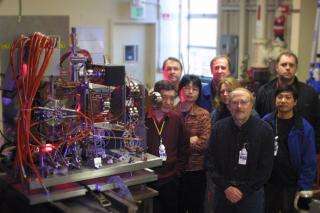Have Gun, Will Travel (at Light Speed)

The front third of the linac is undergoing an extreme makeover, metamorphosing into a first-of-its-kind hard x-ray free-electron laser, the Linac Coherent Light Source (LCLS). But even with the engineering magic embodied by hi-tech vacuum chambers, magnets, undulators and diagnostic equipment from top labs across the country, the LCLS will stand idle without one final, crucial piece of the puzzle: electrons.
That's where the radio frequency (RF) electron gun comes in, an engineering marvel that does one job exceedingly well: under the shine of a special laser, the gun creates a precisely shaped pulse of electrons which it kicks into the linac. The electrons then zip through to the business end of the LCLS where x-rays are produced.
"We believe we've created the best RF gun possible," said David Dowell, who leads the team that designed and built the electron gun. "We left no stone unturned. In our eyes it's a thing of beauty."
What makes the new LCLS electron gun special is how engineers have turbocharged it to not only generate a very precise pulse of electrons, but to ramp the pulse up to 99.7% of the speed of light before it even leaves the gun. This initial boost of acceleration is crucial for creating the extremely tight bunch of electrons needed to produce the brightest x-rays possible as the pulse races through banks of undulator magnets.
Electrons, being negatively charged, naturally repel each other, causing an electron bunch to spread apart as it travels. That effect diminishes as an electron bunch gains energy down the accelerator. To avoid losing the precise pulse shape before the bunch leaves the gun, engineers designed the gun to hold pulses of accelerating microwaves inside the gun itself, directly around the copper cathode where electrons are produced.
The klystron-generated microwaves used in the gun are generated in the same way as those used to accelerate electrons and positrons in the linac. Electrons speeding down the linac travel on the wavefronts of microwave pulses—what physicists call "traveling waves"—like a surfer riding the face of a swell. In order to do that, however, the surfer must first be traveling at the same speed as the wave.
But because the electrons coming immediately off the surface of the cathode have very low energy, a different kind of approach is used to boost the electrons up to the speed of the traveling wave inside the linac. To accomplish this, the gun creates what physicists call a "standing wave" that pulses up and down but does not move forward. Dowell compared the effect to what would happen to a roller skater at rest if the ground under foot suddenly heaved into a hill, sending the skater speeding downward. The LCLS gun gives electrons their initial push in much the same way, keeping the tight electron bunch intact as the pulse leaves the gun.
The new electron gun combines expertise garnered from four previous generations of similar devices, and has taken teams from all over SLAC four years to produce. Currently the gun is scheduled for installation at Sector 20 in early March.
According to LCLS Injector Physicist Cecile Limborg, the gun presented a host of challenges in terms of operating at the energy required and producing the pulse needed for the LCLS. "It's beautiful as a physics object, and it's beautiful as an engineering object," she said. "So far this has been a success on many levels."
Source: By Brad Plummer, Stanford Linear Accelerator Center





















